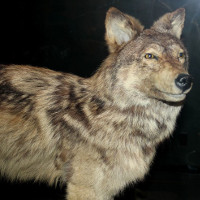 |
Newfoundland wolf |
|
He is a wild animal |
Origin |
Canada | |
Translation |
Francis Vandersteen |
| The possession of this animal is not authorized Royal Decree establishing the list of mammals not kept for production purposes that may be kept (M.B. 24.08.2009) |
| The Newfoundland wolf subspecies was only officially described in 1937 by zooligists G.M. Allen and Thomas Barbour, after it had already been threatened with extinction. Its scientific name, Canis lupus beothucus, comes from the Beothuck, the native Newfoundlanders who were officially declared extinct in 1829. The Newfoundland wolf lived on the island of Newfoundland off the east coast of Canada. Recent evidence has suggested that the first wolves to inhabit the island may have been there before the last Ice Age, surviving the Ice Age in refuges south of the ice cap. The Newfoundland wolf was a medium to large wolf, growing up to 1.67 m long (nose to tail) and weighing up to 45 kg. It was said to be white, with a black stripe down its spine. Caribou was the main diet of the Newfoundland wolf. It also fed on beaver, vole and other rodents. Although hunting, trapping and vigorous predator control methods were used on the Newfoundland wolf, it is thought to have been threatened with extinction mainly by a sudden food shortage in the early 1900s, when the Newfoundland caribou population fell from 120,000 to between 5,000 and 6,000. The last wild wolf on the island was shot in 1911. However, it wasn't until 1930 that it was officially declared extinct. |






 English (United Kingdom)
English (United Kingdom)